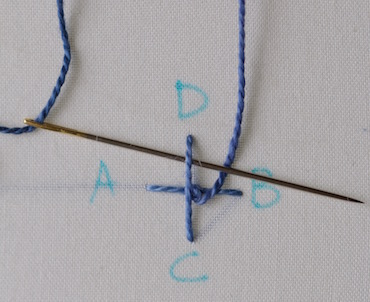- Home
- Basic embroidery stitches
- Raised Buttonhole Stitch
How to Make 3D Raised Buttonhole Stitch Flowers (An Easy Guide)
"How do I do raised buttonhole stitch?" was a question I recently received by e-mail from a visitor to the site.
This is a stitch name that can mean different things, so I asked her to send me a scan of what she was trying to achieve. It turned out to be a stitch that is also commonly called a Raised cross stitch flower. I promised to create a little tutorial for her, so here it is. I hope it helps, Lynn.
The stitch is easiest to do with your fabric held in an embroidery hoop or frame.
Working the raised buttonhole stitch flower
Start by making an upright cross stitch, a - b and then c - d.
I have marked the points with a disappearing ink pen to make it easier to follow the step-by-step photos. There is no need to write these letters on your project.
Bring your needle back up in the center.
Take your needle under the strand of thread labelled B. Ensure the thread is under the point of the needle, and work a buttonhole stitch. The needle does not go through the fabric, just under the horizontal part of the cross stitch.
 Fig 1 - Start with an upright cross stitch
Fig 1 - Start with an upright cross stitchWe are now going to work in an anti-clockwise direction.
Take your needle under the thread leading to point D in the photo. Keep the working thread under the needle and work a buttonhole stitch again.
Gently pull the buttonhole stitches towards the center of your flower as you go until they sit snugly.
 Fig 2 - working the buttonhole stitches
Fig 2 - working the buttonhole stitchesContinue in the same manner, working around the "spokes" of your flower, creating a buttonhole stitch over each spoke.
You may find it easier to turn your fabric as you go. I didn't want to confuse you by taking the photos from different directions.
Remember to pull the stitch gently to snug it up around the center.
For your information I am using a hand-dyed perle 8 thread for this demonstration flower.
 Fig 3 - continue working anti-clockwise
Fig 3 - continue working anti-clockwiseFig 4 shows the circular flower appearing in the center.
After you complete the first circuit of the cross stitch threads, continue around and around, packing in your buttonhole stitches carefully.
You will need to watch your tension. You don't want the stitches too tight or too loose. They should comfortably lay in a spiral, round and around, not bunching up or looking straggly. It can take a little practice.
 Fig 4 - first circuit completed
Fig 4 - first circuit completedI took the photo in fig 5 from a lower angle, so you can see how the needle just slides under the "spoke" and over the working thread.
 Fig 5 - a different camera angle
Fig 5 - a different camera angleFig 6 shows a later stage of the raised buttonhole stitch flower.
You can see from this photo how the stitches wrap around the previous ones, increasing the diameter of the flower. Relax the tension a little as you get closer to the outside.
There is still plenty of room for more stitches here!
 Fig 6 - Building up the flower
Fig 6 - Building up the flowerFig 7 shows the completed flower. Quite by chance, I got the lighter tones of the hand-dyed thread to sit in the center, surrounded by the darker shades. I think it looks quite effective.
 Fig 7 - Completed flower
Fig 7 - Completed flowerThe three photographs below show...
- a second flower worked in the same blue thread, without the distraction of the lettered markings
- one worked in a plain pearl 8 cream thread
- and a raised buttonhole stitch flower worked in 4mm silk ribbon
 Fig 8 - Without the guide lettering
Fig 8 - Without the guide lettering Fig 9 - Plain pearl 8 in cream
Fig 9 - Plain pearl 8 in cream Fig 10 - worked in silk ribbon
Fig 10 - worked in silk ribbon
Stay connected between projects
If you’d like occasional updates from my embroidery room, including new patterns, gentle tips, and little things I think you might enjoy, you’re warmly invited to join the Stitchin’ Times newsletter.
No pressure. Just a friendly note now and then to keep you inspired.





